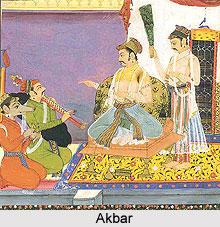 History of Indian music has its origins in divine tradition. The rich history of Indian music unveils the fact that the divine sage Narada introduced the art of music to the Earth from heaven. This is how music is said to have commenced on earth. According to Hindu mythology, the first ever sound to have been heard in the universe is the Naadbrahma or Om mantra. This sound pervades the entire universe. Since it is a manifestation of the divine power (Brahma), it is the purest sound to be heard. It is believed that the musician attempts to achieve this very purity in his 'sadhana' or dedicated pursuit. History of Indian music unfolds the verity that music gradually changed in shape and form. In the beginning the music was devotional in content and was restricted to religious and ritualistic purposes and was purely used in temples only. Indian music developed from the ritualistic music in association with folk music and other musical forms of India and gradually derived its own musical characteristics.
History of Indian music has its origins in divine tradition. The rich history of Indian music unveils the fact that the divine sage Narada introduced the art of music to the Earth from heaven. This is how music is said to have commenced on earth. According to Hindu mythology, the first ever sound to have been heard in the universe is the Naadbrahma or Om mantra. This sound pervades the entire universe. Since it is a manifestation of the divine power (Brahma), it is the purest sound to be heard. It is believed that the musician attempts to achieve this very purity in his 'sadhana' or dedicated pursuit. History of Indian music unfolds the verity that music gradually changed in shape and form. In the beginning the music was devotional in content and was restricted to religious and ritualistic purposes and was purely used in temples only. Indian music developed from the ritualistic music in association with folk music and other musical forms of India and gradually derived its own musical characteristics.Music in Ancient India
The earliest history of music in India can be traced back to the Vedic ages, over two thousand years back. The concept of Naadbrahma is seen being manifest in the Vedic ages. All organised music traces its origins back to the Sama veda which contains the earliest known form of organised music. The earliest raga owes its origin to the Sama veda. The first reference to music was made by Panini in 500 BC and the first reference to musical theory was found in 'Rikpratisakhya' in 400 BC. Bharata Natyashastra, which was written on 4th century AD, contains several chapters on music, which was probably the first clear written work on music that has divided music into octaves and twenty-two keys. The next important work on music was 'Dathilan' that also mentions the existence of twenty-two srutis per octave. According to ancient notion, these twenty-two srutis are the only keys that can be made by the human being. Other works written during this period include 'Brihaddesi' written by Matanga on 9th AD, which attempts to define Raga; 'Sangeeta Makaranda; written by Narada on eleventh century AD, which enumerates ninety-three Raagas and classifies them into masculine and feminine species; 'Swaramela Kalanidhi' written by Ramamatya in the sixteenth century AD and 'Chaturdandi Prakssika' written by Venkata Makhhi in the seventeenth century AD.
During the late Vedic Period i.e. from three thousand to twelve hundred B.C., music prevailed in the form called Samgana, which was purely a chanting of the verses in musical patterns. After that music changed its course a little bit. The epics were narrated in musical tones called 'Jatigan.' Between the second to the seventh century AD, a form of music called 'Prabandh Sangeet', written in Sanskrit language became very popular. This form gave rise to a simpler form called Dhruvapad, which used Hindi language as the medium. The Gupta period is considered as the golden era in the development of Indian Music.
Music in Medieval India
In the medieval period, the nature of Indian music underwent a change due as a result of the impact of the Muslim invasion. At this time, Indian music slowly started branching off into the two distinct forms of Hindustani and Carnatic music. This two traditions of music started to diverge only around 14th century AD. The Persian influence brought a substantial change in the Northern style of Indian music. In the fifteenth century AD, the devotional Dhruvapad transformed into the Dhrupad or classical form of singing. The Khayal developed as a new form of singing in the eighteenth century AD. Carnatic classical or kriti is mainly based on the Saahitya or lyric oriented, while Hindustani music emphasizes on the musical structure. Hindustani music adopted a scale of Shudha Swara Saptaka or Octave of natural notes while Carnatic music retains the style of traditional octave. Both Hindustani and Carnatic music express great assimilative power, also absorbing folk tunes and regional characteristics as well as elevating many of these tunes to the status of ragas. Thus, these two systems of music have mutually influenced each other.
For more, visit the link below: